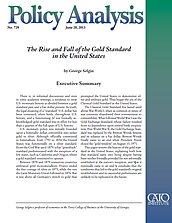U.S. monetary policy was initially founded upon a bimetallic dollar, convertible into either gold or silver. Although officially committed to bimetallism, from 1792 to 1834 the United States was functionally on a silver standard. From the Civil War until 1879, a fiat “greenback” standard predominated with the exception of a few states, such as California and Oregon, where a gold standard continued to operate.
Between 1870 and 1879 numerous countries embraced gold monometallism. France ended the free coinage of silver in 1873, while the rest the Latin Monetary Union followed in 1876. But it was above all Germany’s switch to gold that prompted the United States to demonetize silver and embrace gold. Thus began the era of the Classical Gold Standard in the United States.
The Classical Gold Standard Era lasted until about War World I, when as common in times of war countries abandoned their commitment to convertibility. What followed World War I was the Gold Exchange Standard, whose failure resulted from its dependence upon central bank cooperation. Post World War II, the Gold Exchange Standard was replaced by the Bretton Woods System and its reliance on a fiat dollar. Bretton Woods finally came to an end when President Nixon closed the “gold window” on August 15, 1971.
This paper reviews the history of the gold standard in the United States, explaining both how that standard came into being despite having been neither formally provided for nor informally established at the nation’s inception, and how it eventually came to an end. It concludes that the conditions that led to the gold standard’s original establishment and its successful performance are unlikely to be replicated in the future.

